The Olson Era (1978-2002)
Part 1
Return to the main History page
The lodge experienced its most dramatic growth due to the influence of Lodge Adviser Mr. Howard B. Olson. Taking the helm in 1978, Mr. Olson helped lead a transformation of the lodge into a large, vibrant organization. Under Mr. Olson’s watch, the lodge developed a formal committee system and comprehensive lodge training program. Most of all, Mr. Olson brought a vision of excellence in youth-driven service that continues on to this day.
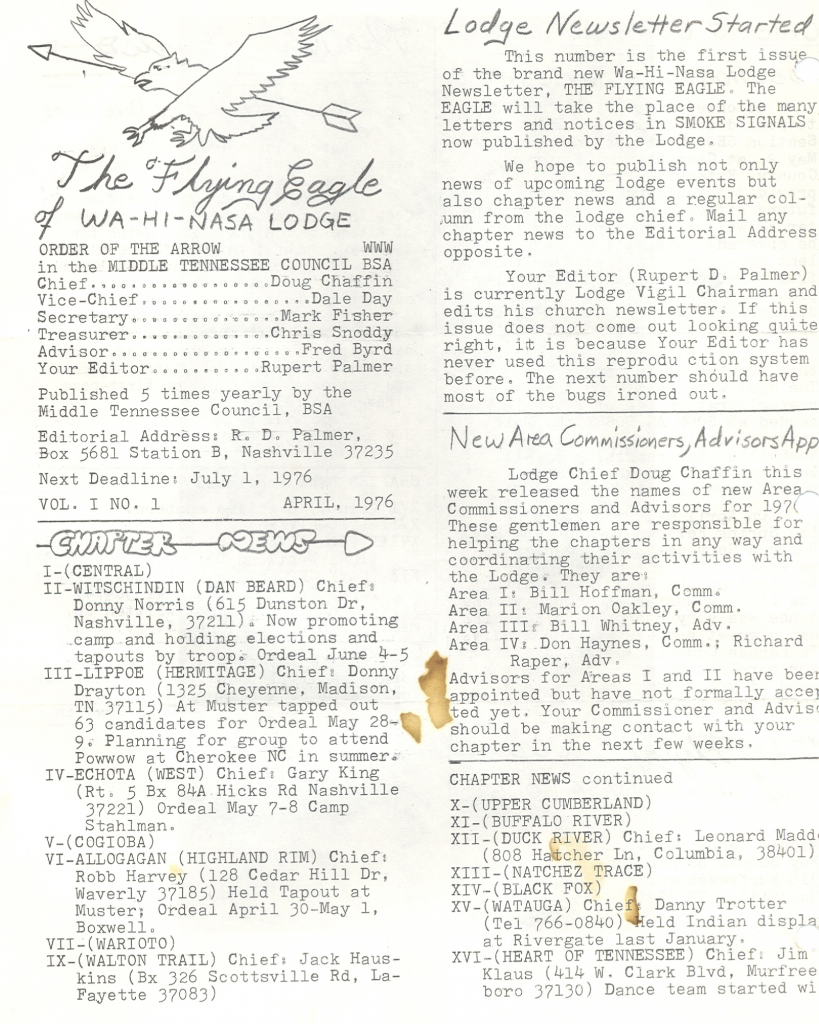
One change that lead up to Mr. Olson taking over control of the lodge was that in 1976 the first edition of the Flying Eagle was produced. Moving the lodge newsletter from “the Bow and Arrow”, to a much more professional looking newsletter, “The Flying Eagle.” Even the process of creating a newsletter has changed greatly since the early 1980’s. There was no email to distribute copies around to edit or simple layout programs to help in the look and feel of the newsletters. Mr. Chris Snoddy, one of the first Flying Eagle adviser’s, tells us about what it took to create a Flying Eagle:
The (Flying Eagle) news letters from this era where edited or advised by me, typed by Ann Minton at the Scout Office on an IBM Selective interchangeable ball type typewriter and in later editions column were right justified by hand which was very labor intensive. Mrs. Minton would often proof read, approve for the council and make great suggestions. I would pick-up the typed columns, drive them down to the Tennessean during lunch time while I was a student at or worked at David Lipscomb College. A volunteer Scouter that we later rewarded with Vigil, Jim Young was the director of the art department. You had to go through security, sign in & they phoned up before you were allowed to go past the front desk. This was rare in the late 70’s & 80’s. He in his spare time would lay it out all by hands. No one had computers to do this back then. Both local papers the Tennessean & Nashville Banner still were typed set daily. Ramona Olson later worked for Mr. Young at the Tennessean. Yes, Ramona is Mr. Olson’s daughter. Craig Salazar was a great editor. Why? He lived in Franklin. His dad worked in Green Hills and would hand deliver the articles usually hand written by Craig or Todd Trapnell to Mrs. Minton. Yes, a large part of Craig’s success was that his father was an excellent courier but yes Craig did his job also. Mr. Young would call me at my home on a land line and I would go back to the Tennessean again during lunch time and pick-up the art work. Take it to the printer and then back to the printer once it was printed. Then, it had to be delivered to the Scout office. Yes it was a lot of running around. John Lambrecht a great volunteer from Dan Beard would run mailing labels. He had great computer knowledge and resources. He could even run the mailing labels in zip code order. Since we used bulk mail this was important. Sometimes the Scout office mail room would apply the labels other times we would have a labeling party at Mr. Olson’s troop or usually at the scout office. Color printing and pictures were hard to do both due to cost and technology. We would have a special edition once or twice a year that might have both red & black ink.
One of the first items that Mr. Olson convinced our lodge that it needed to implement was a recognition program for Arrowmen. The year that Mr. Olson took over as the new Lodge Adviser, five new awards were created. Four youth only awards for people who excelled at different areas of the lodge. These awards were given to the youth that demonstrated excellence in Camp Promotions, Ceremonies, and American Indian Events. The last of the youth only awards was given contributed greatly to the lodge program but had never held a chapter, lodge office, or chairmanship. The fifth award created was that of the Allogagan (Lenni-Lenape word for servant) Award. This award was for both youth and adults that were true servants of the lodge. Much like other lodges have a Scout and adviser of the Year.
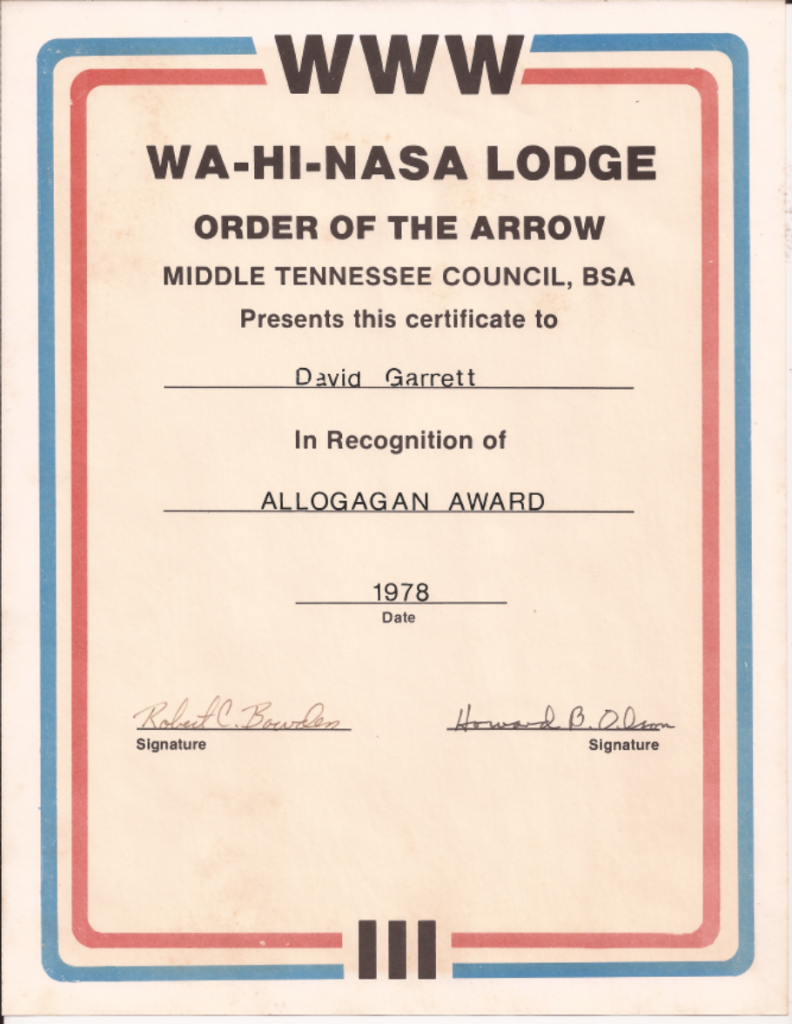
One of the greatest things that Mr. Olson was able to do was to bring the lodge and the council in closer relations with each other. If you look nationally this seems to be one of the greatest challenges for many lodges. A result of this increased relationship can be seen in the 1979 “Boxwell Reservation Leaders Guide.” This guide is one of the first to set aside every Wednesday night of the summer camp season for an OA campfire and tap-out ceremony. The tap-out ceremony was the precursor of the call-out ceremony. Unlike that of today, where call-out ceremonies are conducted at district camporees, tap-out ceremonies were conducted at camp. In keeping with the tradition of the Order beginning in summer camp, every Wednesday new candidates were tapped out to be member of the Order of the Arrow.
This was only one of the by products of the lodge and council having closer relations. Building and maintaining this relationship began again here but has been a major goal for our lodge since this time. The Wa-Hi-Nasa Lodge began to actively look for ways to better help the Middle Tennessee Council. One answer to this question was the lodges service corps at the Scout-O-Rama. Taking on more responsibility than at the previous Scout Circus, the lodge service corps was tasked with taking tickets at the door, performing an Indian pageant, and hosting a lodge booth to promote the lodge events and answer OA questions. The Scout-O-Rama was a major event for the council at this time as it not only served as a “Scout Show” but was also a major recruiting event for youth to come out and join scouting. Building the council/lodge relationship to allow the lodge to be considered as an integral part of the council program truly began with Mr. Olson’s term as lodge Adviser.

In 1979, our lodge decided that there were many ways that it could become integral to the council and the council program. One of these ideas was to have the lodge gather the resources and knowledge of its members to put together a “Where to Go Camping Guide” for all the troops in the council. This booklet was published by asking the experienced Scouters “where are the best places to go camping” and by asking the youth “where did you have the most fun camping.” Once created, a copy was given to each troop in the council and of course you could buy a second copy in the Scout shop. This booklet was debuted at the Scout-O-Rama.
The council, as it is today, was always concerned about the upkeep of Boxwell Reservation. At this time one camp in particular seemed to be in a little neglect. So the lodge created a spring fellowship and workday to center on Camp Murray, a family camp at Boxwell reservation. This camp allowed the families of camp leaders and camp staff to stay at Boxwell while the adult was at camp. This included a small program for younger kids and a food service program. This work day was centered on five hours of platform repairs and then allowed Arrowmen to have fun and fellowship with each other.
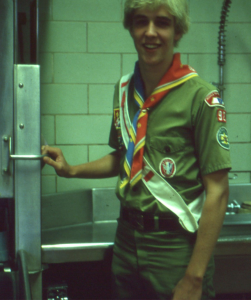
To make any organization grow, members must be trained to do their jobs and training was a something the Mr. Olson believed in greatly, coming for the Marine Corps. So in June of 1979 the first Blue Arrow training was held for adults. Training for the youth was at the time called Red Arrow Training. This training cycle of youth training in the Red Arrow Training and adults being trained with the Blue Arrow training was continued for many years. Added to this training cycle was that of Lodge Officer Training (LOT). This LOT was planned in a three meetings format. The first LOT was for lodge officers alone, the second was for the committee chairman and their advisers (LOT II), while the third (LOT III) was a follow up with the committee chairman and advisers. LOT II was typically held the day of the Winter Banquet and LOT III was typically mid-January.
The lodge calendar of this time looked a lot different than it does today. The lodge held the Red and Blue Arrow Training on separate weekends in March. The Spring Ordeal was still the beginning of June while the Fall Ordeal was in September and the Fall Fellowship was in October.
At the 1979 National conference, one of our lodge members was honored by being the first member of our lodge to receive the Orders Distinguished Service Award. Mr. Ketron, Sr. was a former lodge adviser and at this time was the current section adviser. Mr. Ketron would go on to be the first member of our lodge to serve on the OA national committee and serve as the Southeast OA Region chairman.
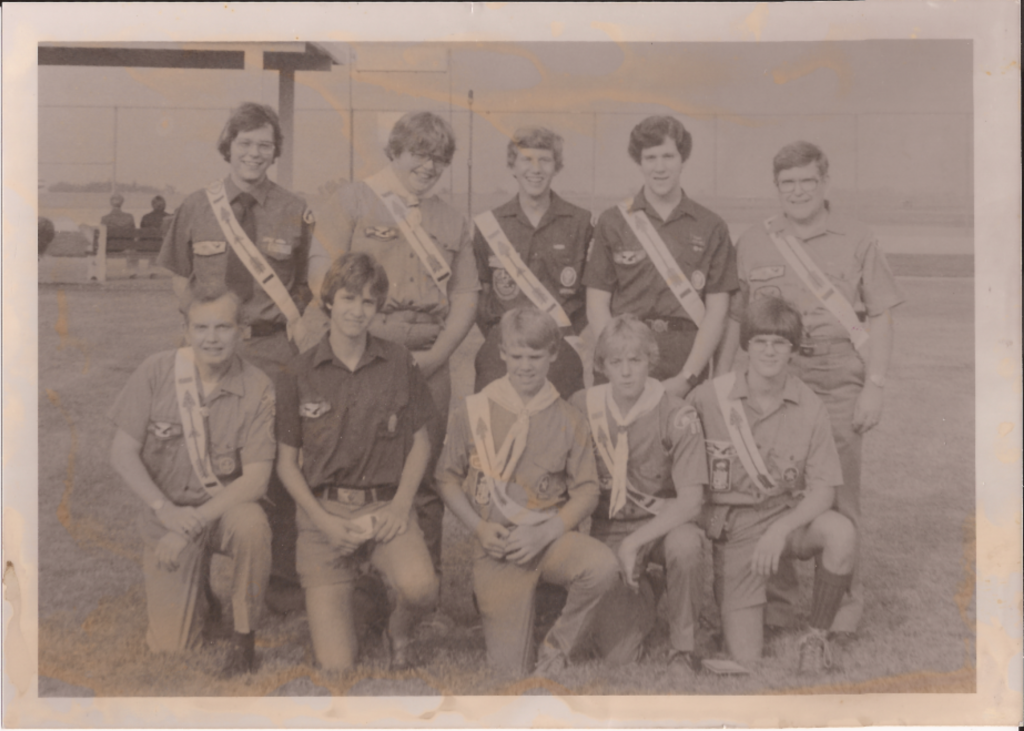
The lodge at this time was also very strong in American Indian Affairs. The lodge repeatedly went to conclave and showed well, with several of the finalists in dancing and costuming being from Wa-Hi-Nasa. Roger Conley won the old style solo dancing several years (79-80) then passed this off to Calvin Hughes. This success developed into a strong at the 1981 National Order of the Arrow Conference (NOAC). The lodge presented a team that placed third in the nation for the singing competition. This team consisted of Jim Johnson, Mike Hayes, Calvin Hughes, Roger Conley, Rex Miller, Tony Massa, and Carl Head. Later, in 1981 our lodge was rocked when Calvin Hughes passed away. The next year saw this Natchez Trace chapter chief being memorialized by the creation of the Calvin Hughes Memorial Fund. This fund’s designated purpose is to provide financial assistance to Arrowmen to attend the NOAC. Since the time that this was enacted hundreds of Arrowmen have been given the help to attend NOACs.
The 1980 Arrowman’s Personal Involvement Award was created for Arrowmen to serve the Scouting program where their primary responsibility lies, at the unit level. First introduced at the 1979 National Order of the Arrow Conference (NOAC), the requirements for the award were created to allow Arrowmen to earn the award completely in the unit. The requirements for youth (under the age of 18) covered the areas of Troop Program Involvement, the Troop Camping Experience, Webelos-To-Scout Transition, and Family Understanding. The requirements for adults (over the age of 18) were similar, but the requirements called for Arrowmen to play an advisory role in the youths’ fulfillment of their requirements. As typical with a successful program, the national committee decided to continue this program for a second year. Those that received the award in the first year received an award patch dated 1980, for those who continued or started late, a second patch was made dated 1981.

Our lodge seemed to take on the professionalism of Mr. Olson. With this change several other opportunities started to present themselves to the lodge. One of these opportunities was a National Leadership Seminar being held on the campus of MTSU. Mr. Ketron played a key role in securing this event as he was Section Adviser. This was a region event but the Wa-Hi-Nasa Lodge was asked to serve as a host lodge. The region chief at the time wrote a thank you letter to the lodge of the “excellent work” that we performed. This letter was partially reprinted in an issue of the Flying Eagle.
The early 80’s was a time of a lot of first for our lodge. One of the items Mr. Olson saw that needed to be changed when he began his term as Lodge Adviser was that of how our membership records were kept. So before LodgeMaster, before Windows and before the personal computer the lodge membership was kept on an actual paper list at the council office. Not only did you have the problems of people being left off the list but of reproducing this list and being able to accurately tell chapters who were dues paid and who were not. In 1981 Mr. Olson found a resource that could help solve this problem. Mr. John Lambrecht, worked as a computer engineer for the Corps of Engineers. Using the best technology of the time, John went about using punch cards to program and stores the lodge membership. Not only did John initially put the lodge membership “on Computer” but he spent the next decade and a half maintaining this list. This was the first time that a chapter could get reports of who showed up and who was actually registered. Mr. Lambrecht started by asking chapter advisers to obtain telephone numbers, ranks, date of Ordeal, Brotherhood, and/or Vigil, date of birth, and chapter office of all the chapter members with their chapters.
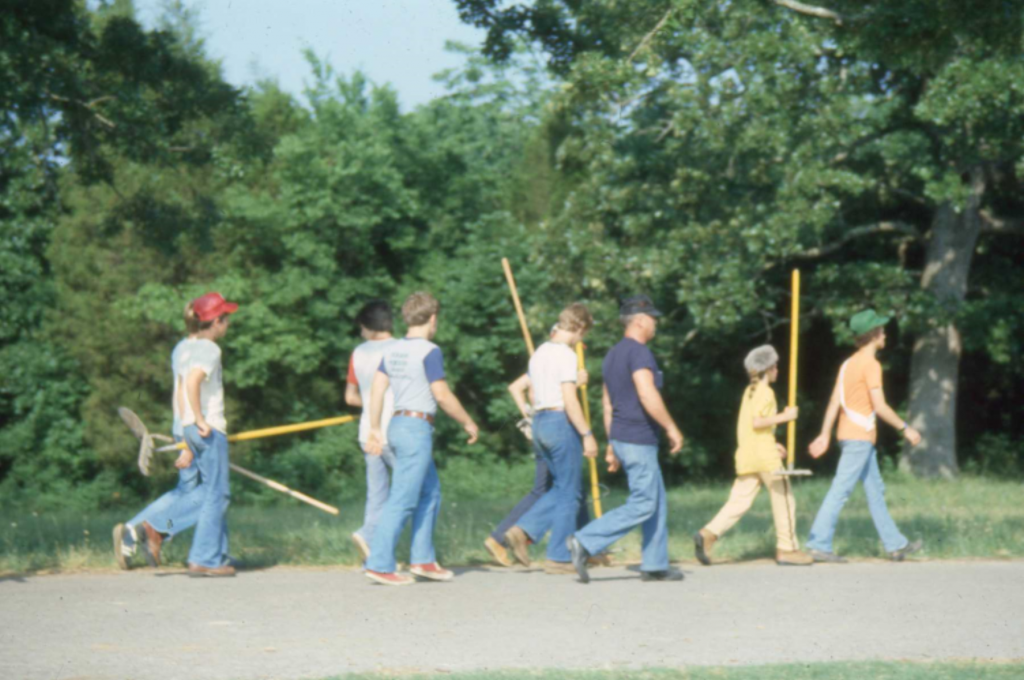
The time came again for Wa-Hi-Nasa to host conclave in 1981. This conclave was particularly special in that this was the first time that the Section 2A (most of Tennessee) and Section 2B (most of Kentucky) would hold a conclave at Boxwell Reservation. To get ready for this conclave our lodge created its first service flap. This flap had a set of requirements that included working at a special pre-conclave work day on April 11. Initially sixty three (63) people earned this service flap. This flap for many collectors is considered one of the hardest flaps to acquire.
This was the first time that the lodge took steps to formally preserve our lodge history by creating a historical committee to help collect the history of our lodge. One of the first tasks of this committee was to collect information like the list of lodge chiefs and lodge officers. Prior to this attempt not much if any information was collected and saved in the hand of current lodge members. In fact an article in the July 1981 Flying Eagle asks for any information people had before 1977. Much of this work is the basis of the list on awards and lodge chiefs that we still print annually in the Lodge Planbook today.
Wa-Hi-Nasa decided to try to attract a greater attendance to the Fall Fellowship by moving the event from October to August. So the Fall Fellowship was moved. For a change like this to happen there had to be some exciting new program to help the promotion of the event. The leadership team of this event did not underwhelm and they picked a new focus of the event to be the newly created Earth Ball game. This was not the only new item at this event. When lodge elections rolled around on Sunday, there was a new officer to elect. The second vice-chief would be elected to serve in 1982. This change was ratified by the lodge executive committee at the previous spring Ordeal.
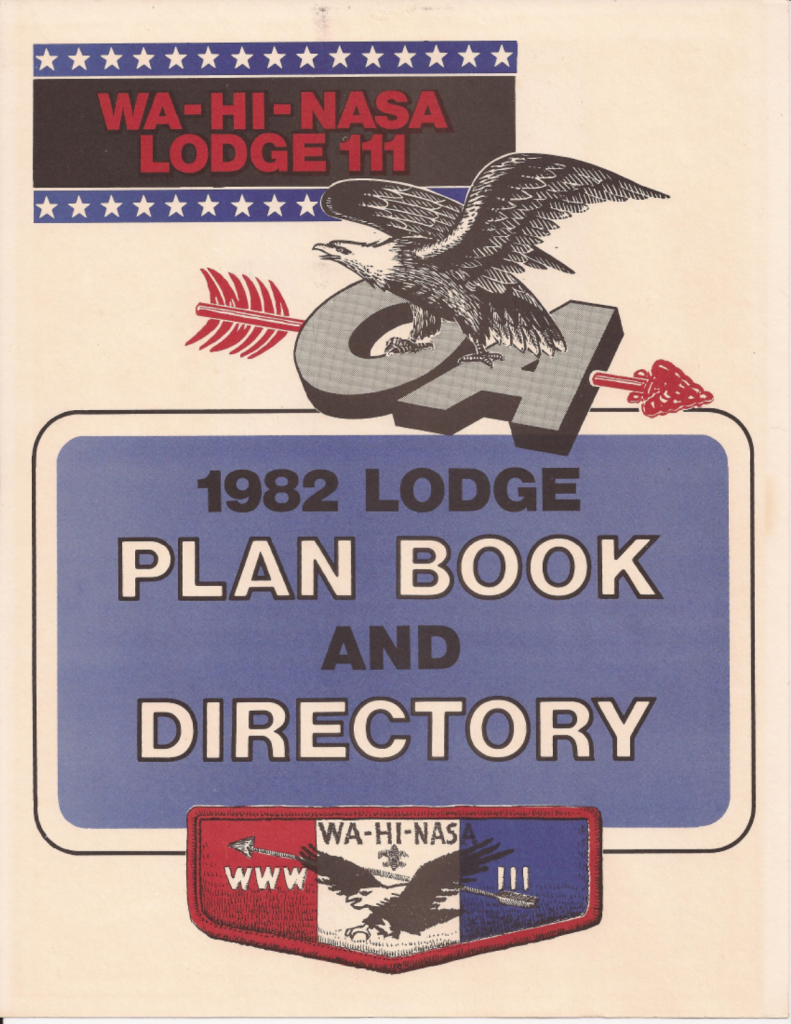
Another first in this time included the first Lodge Planbook in 1982. The Planbook has always been a useful tool to lodge members. Not only having who is the leadership of the lodge and committee chairmen but also to be able to have these leaders of the lodge conveys the goals for their committee. This helps new Arrowmen to see what is going on and where they can best fit into our lodge. Our Planbook has been unique in that since the beginning there has always been a list of members with their contact information.
As 1982 wound down the lodge continued to serve the council at Scout-O-Rama and at the Spring Ordeal. It also continued to train the youth and adults in the separate events at Red and Blue Trainings. David Garrett a former lodge Chief was elected for his second, nonconsecutive, term as Section chief. Then at the end of 1982 Mr. Olson stepped down as lodge adviser, after serving for five years, to take the position of Section Adviser from Mr. Bill Ketron, Sr. where he would serve for twelve years.
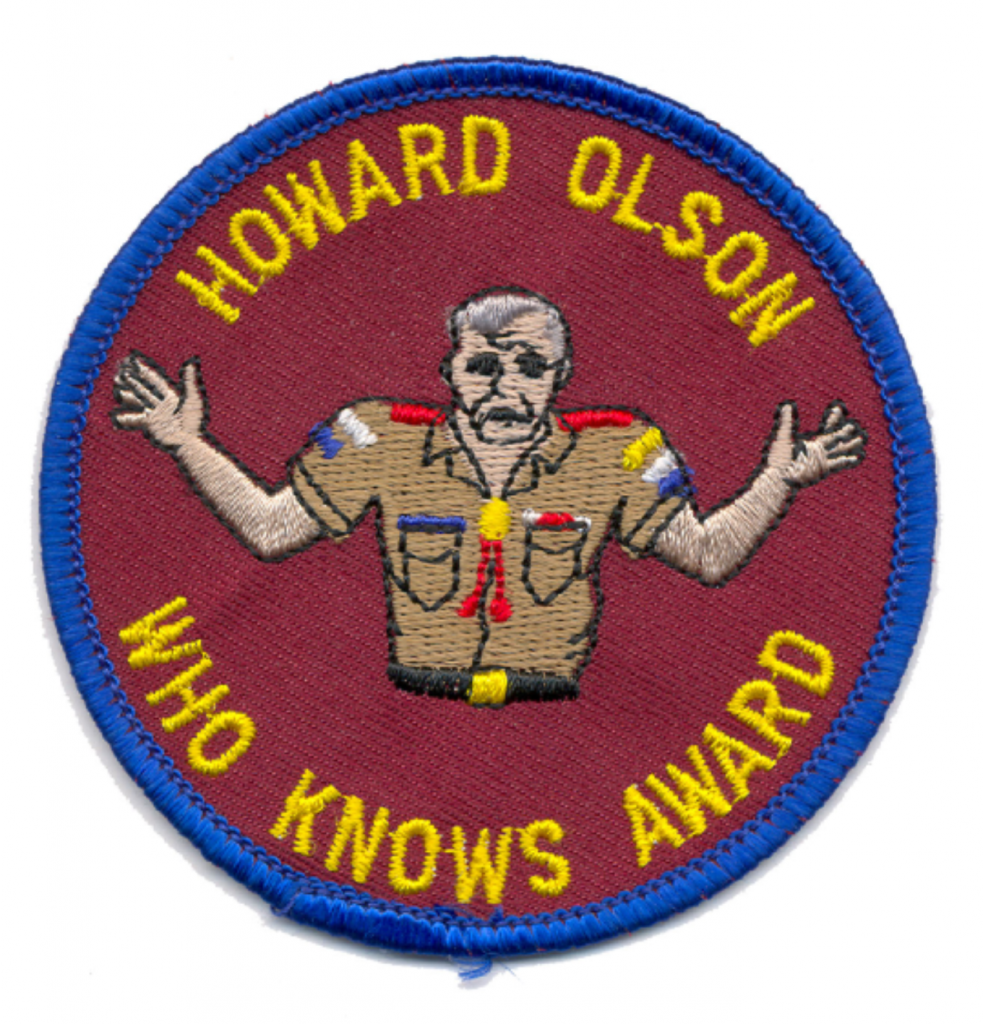
After the passing of the founder of the Order, E Urner Goodman in 1980, the national committee created the Founders Award to honor Arrowmen who have given outstanding service to the lodge. This award is best described by the inscription on the back of the award medal. “He who serves his fellows is of all his fellows greatest.” This award is not always given in a year but if more than one is given than one has to be given to youth under the age of 21. The first year in Wa-Hi-Nasa these were given to David Garrett (youth) and Mr. Chris Snoddy (adult).
Mr. Olson has always been a celebrated leader in our lodge, and even a catalyst for change. Building the lodge from a good lodge to creating a great lodge would not have been possible without the youth leaders being able to buy in to what Mr. Olson was saying. Youth leaders like lodge chiefs David Garrett and Rex Miller really took the reins and help build a lodge that we all can be proud of.
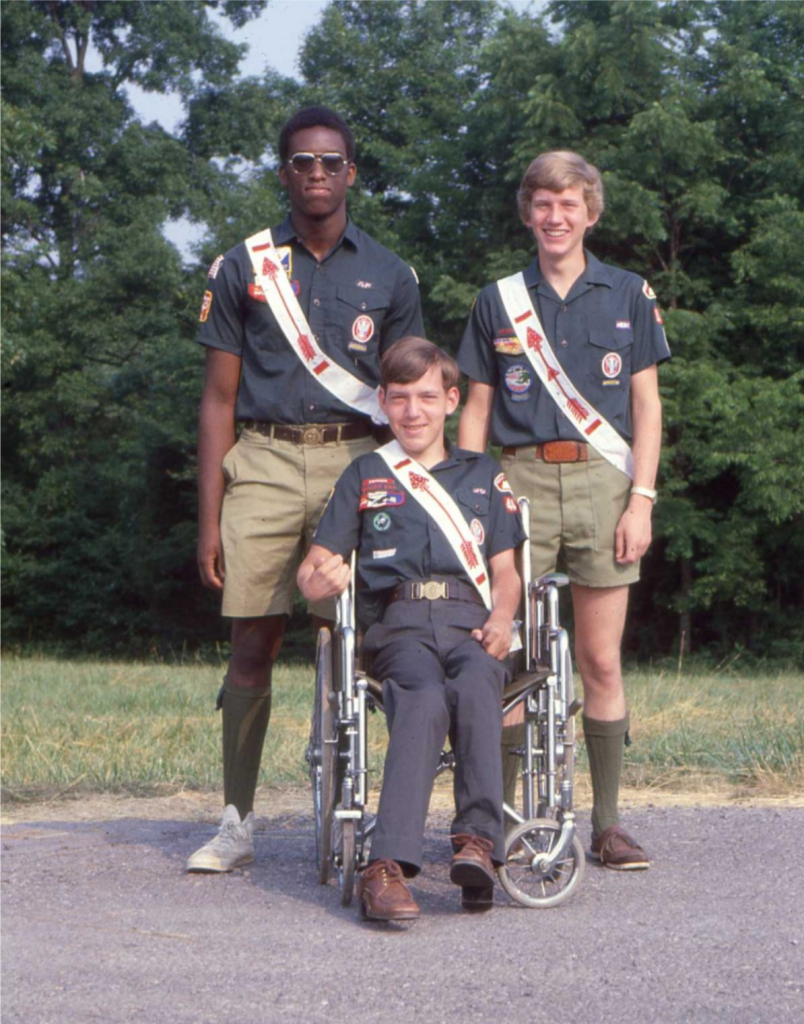
In 1983 there was a special work day at Boxwell to help clean up the camp, help prepare for the upcoming Ordeal and also build a ceremonies ground. The next year the lodge started a year and a half project to build a central campfire area between Camp Stahlman and Camp Parnell. This camp fire area is one of three areas on Boxwell reservation that has the OA’s name on it, the OA Amphitheater. Boyd Williams and Mr. Phil Pheffer lead the lodge in this project.
In 1984, the youth publications chairman, Craig Salazar, had the idea to publish the second supplement of the “Where to Go Scouting” guide in the same booklet as the lodges Planbook. The theory was that it would house a lot more useful information for the Scoutmasters in one place. This was a huge success but printing cost was at an all-time high.
In 1984, training also took on a face lift. Up until this time the youth training (Blue Arrow) and the adult training (Red Arrow) were held on separate weekends in March. Now the experiment was held to hold both trainings on the same weekend and in the same location. The next year also saw training offering basic and advanced training for the adults along with the youth training and elangomat training.

The lodge’s 1985 calendar underwent a major change. Fall Fellowship was moved to September while the Fall Ordeal was moved to August. A special event also arose in the National OA Philmont Trek. This first year the lodge had three members go on contingent while having several others on staff. The contingent consisted of Boyd Williams, Todd Trapnell, and Mark Buford. The amphitheater was finally finished after 2 year of work and the dedication took place on October 26th, 1985.
Wa-Hi-Nasa then took a leap and started to show on the national stage. NOAC of 1986 was a turning point when the southeastern region chief submitted his resignation. Todd Trapnell the current section chief from Wa-Hi-Nasa was picked to fulfill the term of the 1986-1987 Region Chief. Todd was thus the first youth from Wa-Hi-Nasa to serve in a national office. Also at this conference Mr. Olson was the recipient of the Order’s Distinguished Service Award. Just after Todd’s appointment Mr. Bill Ketron Sr. became the first member of Wa-Hi-Nasa to be appointed to the national OA committee in 1987. Mr. Ketron went on to the committee to serve as the Southeastern OA Region chairman which he did for five years.
Even when new programs were started, Wa-Hi-Nasa seemed to jump ahead of the curve. This year a new idea for a competition came to conclave. This new competition was a jeopardy style OA trivia game that was won by the team of Boyd Williams, Bobby Inmon and Bruce Burgess.
